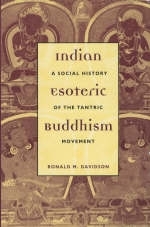
Indian Esoteric Buddhism
A Social History of the Tantric Movement
Seiten
2002
Columbia University Press (Verlag)
978-0-231-12619-9 (ISBN)
Columbia University Press (Verlag)
978-0-231-12619-9 (ISBN)
Drawing on primary documents, this work describes the historical origins of the Tantric movement in early medieval India. It shows how changes in medieval Indian society led to the rise of the esoteric tradition in India that became the model for Buddhist cultures in China, Tibet and Japan.
Despite the rapid spread of Buddhism-especially the esoteric system of Tantra, one of its most popular yet most misunderstood forms-the historical origins of Buddhist thought and practice remain obscure. This groundbreaking work describes the genesis of the Tantric movement in early medieval India, where it developed as a response to, and in some ways an example of, the feudalization of Indian society. Drawing on primary documents-many translated for the first time-from Sanskrit, Prakrit, Tibetan, Bengali, and Chinese, Ronald Davidson shows how changes in medieval Indian society, including economic and patronage crises, a decline in women's participation, and the formation of large monastic orders, led to the rise of the esoteric tradition in India that became the model for Buddhist cultures in China, Tibet, and Japan.
Despite the rapid spread of Buddhism-especially the esoteric system of Tantra, one of its most popular yet most misunderstood forms-the historical origins of Buddhist thought and practice remain obscure. This groundbreaking work describes the genesis of the Tantric movement in early medieval India, where it developed as a response to, and in some ways an example of, the feudalization of Indian society. Drawing on primary documents-many translated for the first time-from Sanskrit, Prakrit, Tibetan, Bengali, and Chinese, Ronald Davidson shows how changes in medieval Indian society, including economic and patronage crises, a decline in women's participation, and the formation of large monastic orders, led to the rise of the esoteric tradition in India that became the model for Buddhist cultures in China, Tibet, and Japan.
Ronald M. Davidson is professor of religious studies and director of the program in Asian studies at Fairfield University in Connecticut. He is the coauthor (with Steven D. Goodman) of Tibetan Buddhism: Reason and Revelation.
1. Introduction: A Plethora of Promises 2. Early Medieval India 3. The Medieval Buddhist Experience 4. The Victory of Esoterism and the Imperial Metaphor 5. Siddhas and the Religious Landscape 6. Siddhas, Literature, and Language 7. Siddhas, Monks, and Communities 8. Conclusion: The Esoteric Conundrum Appendix: Probable Pasupata Sites
| Erscheint lt. Verlag | 18.12.2002 |
|---|---|
| Zusatzinfo | 23 illus, 4 maps |
| Verlagsort | New York |
| Sprache | englisch |
| Themenwelt | Geschichte ► Teilgebiete der Geschichte ► Religionsgeschichte |
| Geisteswissenschaften ► Religion / Theologie ► Buddhismus | |
| ISBN-10 | 0-231-12619-0 / 0231126190 |
| ISBN-13 | 978-0-231-12619-9 / 9780231126199 |
| Zustand | Neuware |
| Haben Sie eine Frage zum Produkt? |
Mehr entdecken
aus dem Bereich
aus dem Bereich
Herkunft, Blüte, Weg nach Osten
Buch | Hardcover (2024)
C.H.Beck (Verlag)
CHF 55,90
Von den Anfängen bis zur Gegenwart
Buch | Hardcover (2022)
C.H.Beck (Verlag)
CHF 47,60
warum die Religionen erst im Mittelalter entstanden sind
Buch | Hardcover (2024)
C.H.Beck (Verlag)
CHF 53,20


